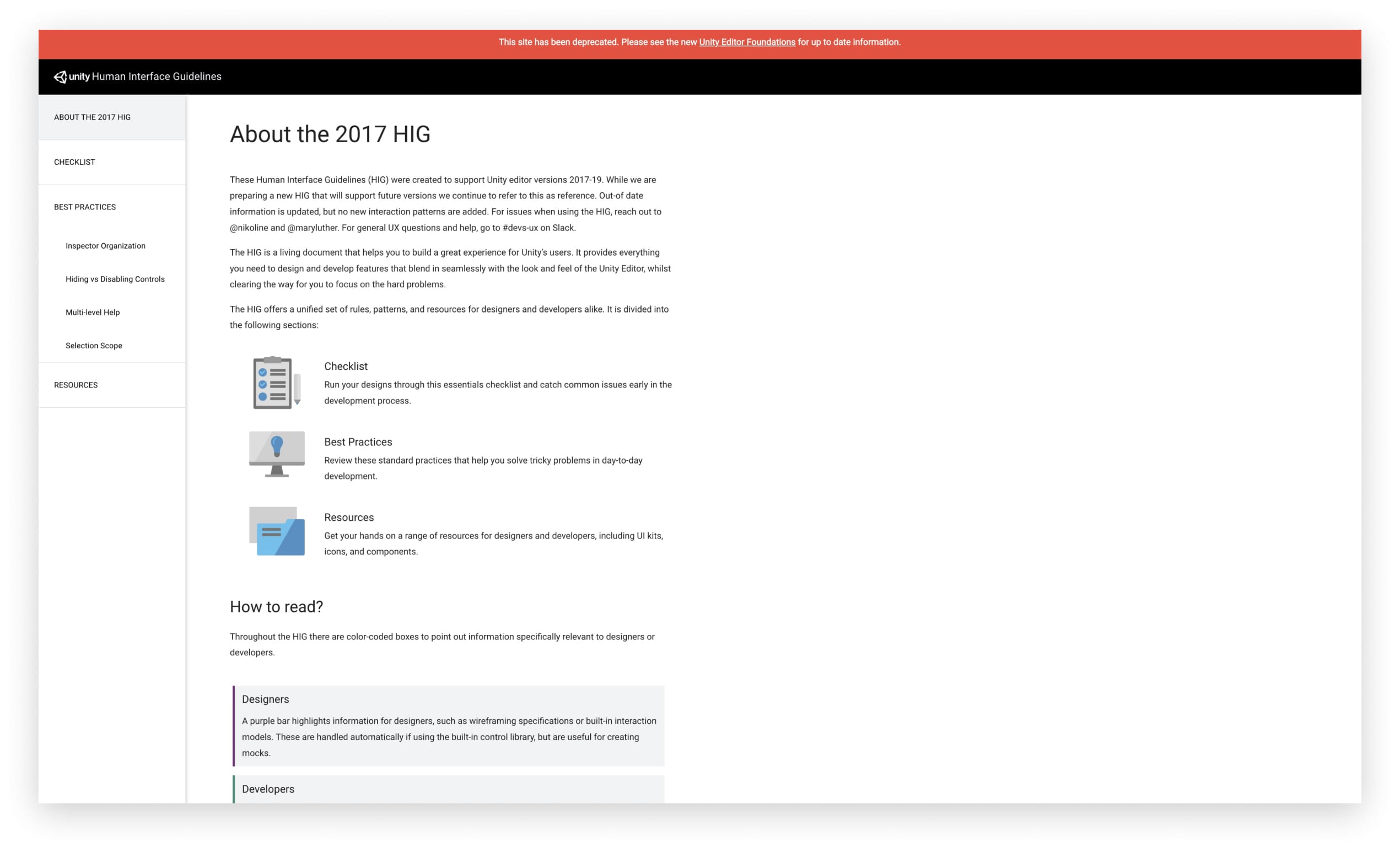
I joined Unity in 2016 as the R&D Product Design Lead when the company was roughly 1,000 in size and we had less than 15 designers. In the hiring and onboarding process, multiple executives expressed interest in having a set of self-serve resources on how to design and work with the Unity platform.
As the lead for the R&D design team, I collaborated with my team to design and write content for the project and gather insights from internal and external users. I actively engaged with senior leadership to advocate for the project and ensure it was aligned with the R&D divisions goals helping to define success metrics and KPI’s to measure the project’s impact and effectiveness.
Challenge
Unity started as a simple and straightforward engine that was perfect for mobile development. Over the years, the engine needed to change and evolve to support more advanced workflows and meet our growing users’ needs. It also needed to support Asset Store developers that were building new tools and content, and third-party platform providers looking to integrate new platforms and devices into Unity.
With limited design resources, we needed something that could provide essential information about platforms, foundations, patterns, components, and other elements of the Unity platform in a self-serve way. To solve this, we created the Unity Human Interface Guidelines (HIG) to help Unity users learn how to make great experiences with the Unity platform.
Solution
My team was responsible for the initial concept and creation of the HIG. The team consisted of myself, another designer, and a design engineer. Inspired by the Apple Human Interface Guidelines, 1987 and Macintosh Interface Guidelines, we designed, wrote, and deployed the first iteration using Jekyll and GitHub Pages. It didn’t need to be perfect, just good enough that we could start pointing teams towards it, get feedback, and iterate on the content.

While this iteration provided the baseline we needed for internal teams, third-parties building for the Asset Store or platform providers didn’t have access to the HIG. In the year since we launched the first version, we were completely redesigning Unity with a new UI system, typography, icons, colours, and platforms. The HIG needed an update to coincide with this work.
We decided to name the second iteration Editor Foundations as we wanted it to serve as the foundational layer for the Unity Editor. Our goal was to provide even more essential information with this iteration and make it relevant to designers, developers, and third-parties. We also wanted to connect it to the new Editor Design System we were working on so users’ could quickly go from reference to implementation. Additionally, we grew the team to include two more designers, a design operations manager, two content designers, and three engineers.

We expanded the scope of content to encompass essential topics such as accessibility, iconography, typography, and interaction design. Additionally, we incorporated design patterns, including authoring flows, inheritance, overlays, and window structures. The expanded content also provided in-depth explorations of key components, such as buttons, fields, and toolbars.
This work also extended to our internal tools and technology that we used to develop Unity. Teams working on our build, infrastructure, source, and other proprietary solutions had access to guidelines and best practices integrated into Foundations. This content isn’t accessible to the public and is only visible on the internally accessible version of the HIG.
Impact
The Human Interface Guidelines, in both its iterations, received an overwhelmingly positive reception from users upon launch. The first version played a crucial role in establishing standards and guidelines across the entire company, effectively filling the gaps where the design team couldn’t scale. It also allowed us to tap into knowledgeable people across the company to contribute and help grow the resource.
The second iteration was launched alongside the Unity 2019 redesign, allowing us to assist Asset Store developers and platform providers in designing and delivering cohesive experiences that aligned seamlessly with Unity’s design language and user experience guidelines. With the deployment of the Editor Foundations Design System we also saw a drastic reduction in inconsistencies with new features and more consistent designs across the Unity platform.